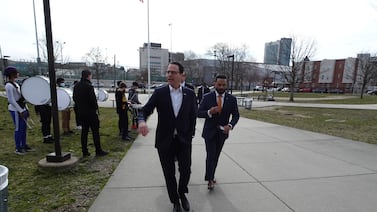Sign up for Chalkbeat Chicago’s free daily newsletter to keep up with the latest education news.
A decade ago, Latisa Kindred fought to bring back the electricity program at Simeon Career Academy, which had been shut down by the school’s principal due to low enrollment. The effort by Kindred, students, alumni, and elected officials paid off – and the program was reinstated.
Now, Simeon’s career and technical education program, where Kindred continues to teach electricity to high school students, is being held up as a model. Last week, Mayor Brandon Johnson toured the high school, visiting carpentry, electricity, and culinary arts classrooms – and even sampling a large breakfast of sausages, bacon, eggs, potatoes, and toast prepared by the high school’s chefs.

“CTE can provide introductions to industries that [students] never knew existed and exposure to opportunities that they never dreamed of,” said Kindred, who has been teaching for about 17 years.
Advocates for CTE programs such as the one at Simeon have praised such programs across the state for introducing students to the trades and helping them land jobs after high school graduation.
In February, Gov. J.B. Pritzker proposed a $10.3 million increase in funding for CTE programs. If the legislature approves his budget proposal at the end of session, the total amount of state funding for CTE programs would be $58 million in fiscal year 2025. Last year, CTE programs received around $48 million in state funding.
This school year, at monthly meetings and during fall budget hearings, CTE advocates asked for a funding increase of at least $10 million from the Illinois State Board of Education. They believe CTE programs can help students get into high-salary jobs right out of high school, grow the state’s workforce and economy, and allow students to start their lives without a large amount of student loan debt. However, data on student outcomes is still unclear, even as school districts like Chicago and across the country continue to invest in CTE programs.
Some school district leaders, educators, and economic developers say they are glad to see a major increase, but think even that might not be enough after years without additional state dollars – between fiscal years 2009 and 2023, state funding stayed mostly flat. They say more is needed due to a rise in demand from students who want to be in CTE programs and the need to expand current facilities and update equipment for classes.
A spokesperson from Pritzker’s office said the governor’s proposal “included a significant increase in CTE funding distributed from general state funds, as opposed to many other states who did not commit to CTE funding beyond the required amount given through Perkins federal dollars.”
Across the state, enrollment for career and technical education programs has gone from around 285,000 students during the 2019-20 school year to about 300,000 students last school year, a 5% increase. Some high school programs have had to turn away students due to lack of space, say school district leaders.
At the state board’s meeting in February, Brad Skertich, superintendent of Collinsville Community Unit School District 10, asked for more funding for CTE programs. In his district, high school juniors and seniors can take classes in fields such as cosmetology, dental assistance, and automotive repair at the Collinsville Area Vocational Center. The vocational center serves students from Collinsville and eight other high schools from districts in the surrounding area.
Skertich said companies are reaching out to his school district to see which students can work in the field after completing the two-year program.
“We have not seen those public-private partnerships before and they’re exploding each year. The demand is more and they’re looking to hire our students,” he said. “So we find ourselves in a unique time.”
The nine high schools connected to the Collinsville Area Vocational Center received about 700 requests from students to enroll in CTE programs during the 2024-25 school year. However, because the center’s maximum capacity is 500 students, it does not have the space to absorb so many students at once, according to Skertich. He said this has happened every year for the past three years and demand for classes continues to grow.
Adam Seaney has seen a similar trend at the Galesburg Vocational Center in Western Illinois. As vocational director of the center, Seaney has seen an increase in demand for programs such as automotive, construction, and nursing.
Seaney said the coalition will continue to “beat the drum” to ask the state for more funding to get more students into programs and to afford equipment.
“When you look at inflationary increases on the equipment that we use in our center and centers across the state. It’s expensive,” said Seaney. “They’re great programs to have and we’re excited to be able to have those programs but it’s expensive.”
Some advocates of career and technical education programs say the programs help increase the number of workers in fields that have shortages, such as nursing, and attract more business to Illinois to help the state’s economy.
For over a decade, said Ken Springer, president of the Knox County Area Partnership for Economic Development, he has heard companies say there were not enough workers in Western Illinois to meet their demands. Now, Springer and his organization work closely with CTE programs at high schools and community colleges to help students find jobs after graduation.
“The story of economic development in the 21st century is about talent. It’s about workforce skills. Every state is competing against each other,” said Springer. “If Illinois wants to continue to be at the head of the pack in terms of being able to attract companies across the state, CTE is one pathway to do that.”
Samantha Smylie is the state education reporter for Chalkbeat Chicago, covering school districts across the state, legislation, special education, and the state board of education. Contact Samantha at ssmylie@chalkbeat.org.







